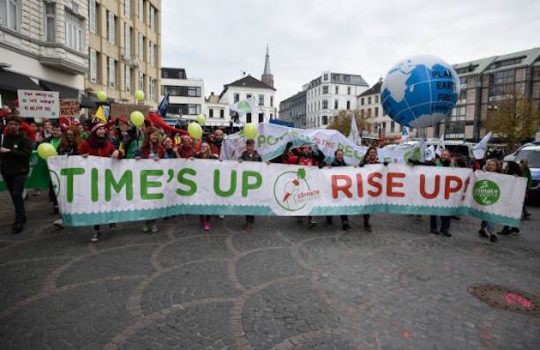Scientists are once again sounding the alarm that humans are destroying the planet, and we're heading towards a "mass extinction event."
"We the undersigned, senior members of the world's scientific community, hereby warn all humanity of what lies ahead," wrote over 15,000 scientists from 184 countries—an irrelevant fact to make it sound like a consensus. "A great change in our stewardship of the earth and the life on it, is required, if vast human misery is to be avoided and our global home on this planet is not to be irretrievably mutilated."
Sounds dire. But don't worry, they're always wrong.
The group called their letter "World Scientists' Warning to Humanity: A Second Notice." You might wonder why this is their second notice. What did they predict the first time?
As Investors Business Daily points out, the first notice, published in 1992, got everything wrong.
They warned of water shortages. "Global supplies of clean water have increased" to 89 percent. They warned fisheries would collapse. "The per-capita supply of fish worldwide climbed roughly 30 percent." They warned of becoming "trapped in spirals of environmental decline, poverty, and unrest, leading to social, economic, and environmental collapse." World hunger is down significantly since 1990, despite population growth of 1.9 billion. They warned of "widespread injury to humans, forests, and crops" caused by air pollution. In America, air pollution is "down since 1992 for every single pollutant the EPA measures."
They warned of "stratospheric ozone depletion." Even the World Scientists have to admit they got this wrong.
"Since 1992, with the exception of stabilizing the stratospheric ozone layer, humanity has failed to make sufficient progress in generally solving these foreseen environmental challenges, and alarmingly, most of them are getting far worse," the scientists now write.
That's a big exception. The ozone hole has shriveled to its smallest peak since 1988.
Like the first "warning to humanity," the letter is an anticapitalist, antifamily screed. For environmentalists, it always seems to come down to population control.
The 1992 letter's prescription for a doomed planet was, of course, stop having children. "We must stabilize population," implement family planning, and "ensure sexual equality, and guarantee women control over their own reproductive decisions," they said.
Environmentalists have long warned us about overpopulation, and they were wrong about that, too. Here are other doomsday climate predictions that never panned out.
'Population Bomb'
Paul R. Ehrlich, a Stanford University biologist, published "The Population Bomb" in 1968, warning that "humankind stood on the brink of apocalypse" because of too many babies. Ehrlich predicted that 65 million Americans would starve to death during the 1970s, and "England will not exist in the year 2000." He ended with his gravest prediction: "Sometime in the next 15 years, the end will come."
"As you may have noticed," observed the New York Times over four decades later, "England is still with us. So is India. Hundreds of millions did not die of starvation in the '70s."
Unsurprisingly, Ehrlich was a signer on both the 1992 and 2017 letters.
Al Gore's Vanishing Polar Ice Caps
In 2009, Al Gore said the Arctic ice cap would melt by 2014. "There is a 75 percent chance that the entire north polar ice cap during some of the summer months could be completely ice free within the next five to seven years," Gore said at a United Nations climate conference in Copenhagen.
Gore based his prediction off of models conducted by Dr. Wieslav Maslowski, a climatologist. He was quickly condemned for making the prediction, as Dr. Maslowski said, "I would never try to estimate likelihood at anything as exact as this."
Other "experts" gave us two more years than Gore. They were wrong, too.
It turns out there is "far more" sea ice in the Arctic now than before. Last year, there was 1.6 million square miles of sea ice, 21 percent more "than the lowest point in 2012," the Telegraph reported.
New York 'Underwater' By 2018
Jim Hansen, perhaps the greatest alarmist who coined the phrase "global warming" (his honorary title has since changed to "father of climate change awareness") told author Bob Reiss in 1988 that New York City would be underwater in 20 years.
"The West Side Highway [which runs along the Hudson River] will be under water," Hansen said. "And there will be tape across the windows across the street because of high winds. And the same birds won't be there. The trees in the median strip will change."
Hansen has not stopped his alarmism, but he has pushed back his timeframe about 100 years. In 2015, he released a study claiming New York, London, and Shanghai will be uninhabitable due to sea level rise "before the end of the century."
So New York will still be here next year. But other than that, Hansen isn't sure about anything else. "Will the full-fledged consequences be in 50 years, 100 years, 150 years?" he told New York magazine in 2016. "I can't imagine it will be greater than that range."
NASA has reported that sea-level rise has slowed by roughly 20 percent in the past decade.
Rachel Carson's 'Silent Spring'
In the 1960s environmentalist Rachel Carson's propaganda campaign got the pesticide DDT banned, based on her book "Silent Spring." The book predicted DDT would kill birds, animals, cause birth defects, and lead to the sudden death of children.
Millions of children have died—not from DDT, but from malaria that the pesticide could have prevented.
"Since the mid 1970s, when DDT was eliminated from global eradication efforts, tens of millions of people have died from malaria unnecessarily: most have been children less than five years old," according to the Daily Beast.
Carson's warnings about the dangers of DDT were wrong. Studies in Europe, Canada, and the United States "have since shown that DDT didn't cause the human diseases Carson had claimed."
